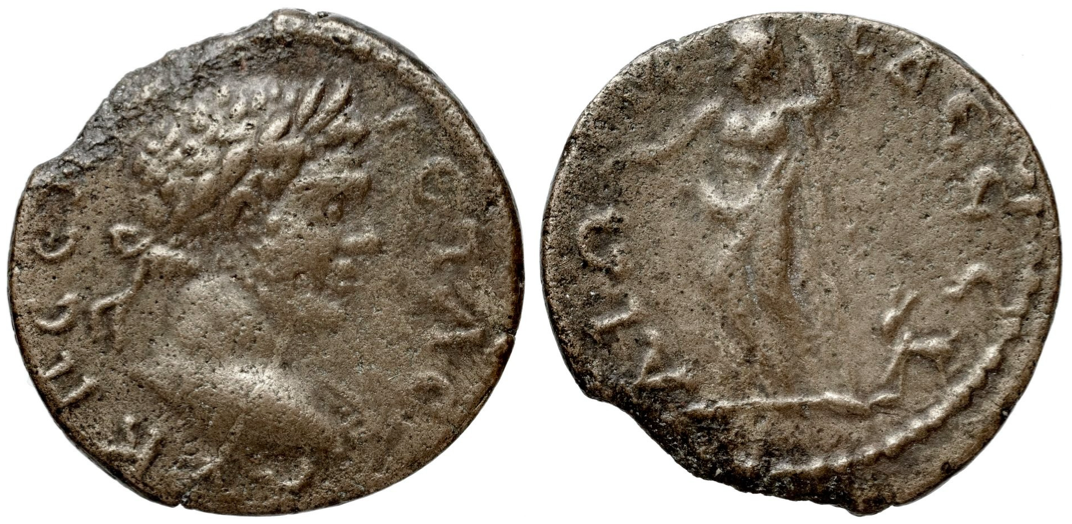RQEM ad. 18 - Edessa (Macedon) (Septimius Severus), bronze, asses (198-211 CE)
From SILVER
198 CE - 211 CE Bronze
Description
| ObverseInscription or printing placed on the obverse.: | Several legends: 1) Αὐ(τοκράτωρ) Κ(αίσαρ) Λ(ούκιος) Σεπ(τήμιος) Σευῆρος Ε(ὐσεβής) ; 2) (Αὐτοκράτωρ) (Καίσαρ) (Mᾶρκος) (Aὐρήλιος) Ἀντωνῖνος Eὐσ(εβής) ; 3) Αὐ(τοκράτωρ) Π(ούβλιος) Σεπ(τήμιος) (Γέτας) or Γέτας (Greek).Head of Septimus Severus right, (bearded), wearing laurel wreath. Border of dots. |
| ReverseInscription or printing placed on the reverse.: | Several legends: 1) ᾽Εδεσσαίων ; 2) ᾽Εδεσσέων (Greek).Different types: 1) Personified Edessa facing, head left, wearing mural crown and peplos, holding female statue (Nike?) in right hand, and a spear in left hand. At the City feet, right, goat. Border of dots, 2) Goat against a fruit tree. Border of dots. |
Mint and issuing power
| MintIdentifies the place of manufacture or issue of a numismatic object.: | Edessa | Ancient regionAncient region.: | Macedon | Modern countryModern country: Greece | AuthorityIdentifies the issuing power. The authority can be "pretended" when the name or the portrait of X is on the coin but he/she was not the issuing power. It can also be "uncertain" when there is no mention of X on the coin but he/she was the issuing power according to the historical sources: | Caracalla (Roman emperor, 198-217 AD), Geta (Roman emperor, 209/10-211 AD), Septimius Severus (Roman emperor, 193-211 AD), Roman Empire |
Chronology
| FromIdentifies the initial date in a range assigned in a numismatic context. | 198 CE | toIdentifies the final date in a range assigned in a numismatic context.. | 211 CE | PeriodTime period of the numismatic object.: Roman from 30 BC |
Physical description
| MetalThe physical material (usually metal) from which an object is made.: | Bronze |
Median weightMedian of the weights of numismatic objects (in grams). in grams | 5.30 | DenominationTerm indicating the value of a numismatic object. Examples: tetradrachm, chalkous, denarius.: | as |
StandardStandard.: |
Image

RQEM_ad_18.png "Paris, BnF, 1991.569 (https" has not been listed as valid URI scheme.[Paris, BnF, 1991.569 (https://gallica.bnf.fr/ark:/12148/btv1b8590459s)]
References
| Die study referencePublication of the study: | Papaefthymiou 20021Papaefthymiou 2002, p. 52, no. 1, p. 60, no. 15, p. 61-62, no. 1-3. | ||
| Coin series referenceReference to coin series study: | |||
Obverse dies distribution
| FrequencyFrequency of specimen in distribution. ᵖ | Number of obversesNumber of obverse dies. ᵖ (o) | % (o) | Number of coinsNumber of coins. (n) | % (n) | Die nameName(s) of the die(s). |
| 1 | 4 | 80 | 4 | 66.67 | 1 (Sept. Sev.), 7 (Carac.), 1 (Get.), 2 (Get.) |
| 2 | 1 | 20 | 2 | 33.33 | 3 (Get.) |
| Total | 5 of 5 | 100 | 6 of 6 | 100 |
Reverse dies distribution
no distribution is available
Quantification
| Number of obversesNumber of obverse dies. ᵖ (o) | 5 | Number of singletons (o1)The number of singleton coins. ᵖ | 4 |
| Number of reverse diesNumber of reverse dies. (r) | 4 | Number of coinsNumber of coins. (n) | 6 |
| Coins per obverse dieNumber of coins per obverse die. (n/o) | 1.2 | Coins per reverse dieNumber of coins per reverse die. (n/r) | 1.5 |
| Reverse per obverse ratioRatio of obverse dies divided by reverse dies. (r/o) | 0.8 | Percentage of singletons (o1)number of coins (n) divided by the number of singletons (o1) ᵖ | 80 % |
| Original number of dies (O) (Carter 1983 formula)The estimation of the number of coins according to Carter 1983 ᵖ | 23.09 | Coins struck if 20,000 as average productivity per dieCoins made if the average productivity for obverses (according to Carter) is 20,000. ᵖ | 461,800 |
| Original number of dies (O) (Esty 2011 formula)The estimation of the number of coins according to the singleton formula in Esty 2011 ᵖ (O) | 30 | Survival rate if 20,000 as average productivity per dieSurvival rate if average productivity is 20,000. ᵖ | 0.00001 |
| Coverage (o = % of O) (Esty 1984 formula)Esty 1984 - coverage (% of O) ᵖ (o = % of O) | 33.33% | Die productivity if survival rate 1/2,000Average productivity if survival rate is 1/2,000. ᵖ | 519.71 |
| Weight of silver (in kg) if 20,000 coins per die (O = Carter formula)Carter 1983 * Median weight * 20000 (*10 if gold or electrum) ᵖ | n.a. | Die productivity if survival rate 1/5,000Average productivity if survival rate is 1/5,000. ᵖ | 1,299.26 |
Remarks
The coinage of Septimus Severus is divided in 3 iconographic groups : the coins with the portrait of Septimus Severus (subdivided in 3 issues dated in 198-204/5 AD, 204/5-209/10 AD and 209/10-211 AD), those with the portrait of Caracalla (subdivided in 3 issues dated in 198-204/5 AD, 204/5-209/10 AD and 209/10-211 AD) and those with the portrait of Geta (subdivided in 2 series). The average weight is approximate: 5,18 g for the coins with Edessa and 5,39 g for those with the goat. Metrology p. 189-209.
References
- ^ E. Papaefthymiou, Edessa de Macédoine. Etude historique et numismatique, Athens, 2002